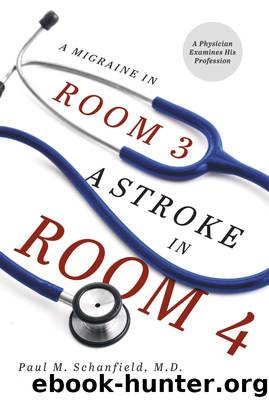A Migraine in Room 3, a Stroke in Room 4 by Paul M. Schanfield MD

Author:Paul M. Schanfield MD [Paul M. Schanfield, MD]
Language: eng
Format: epub
Tags: -
Publisher: BookBaby
Published: 2018-12-18T16:00:00+00:00
While formulating an approach to the patient’s medical problem, the physician should resist the temptation to prematurely place her patient’s case into a narrow diagnostic cubbyhole. It is good medical practice to let the patient talk. It is good medical practice to listen. It is good medical practice to say, “What else?” repeatedly throughout the patient’s recitation of the history until the patient has thoughtfully and thoroughly finished his story. In my experience, “What else?” serves as a better invitation for the patient to raise other issues than “Anything else?”
A patient encounter is, in large part, a healthcare investigative process. These “what else?” questions employed by physicians to clarify a patient’s problem can be considered a doctor’s corollary to the “Five Whys” of Toyota Production (Ohno, 2006). Toyota’s “Five Whys” serve as an in-depth exploration of the cause-and-effect relationship underlying a particular production problem. This system repeatedly asks “why,” delving deeper and deeper until the root cause of the problem becomes crystallized. As in the search for production efficiency, by asking, “What else?” a physician creates an environment wherein all pertinent issues are identified early.
A reasonable and usable approach to interviewing patients includes establishing a connection with the patient (building rapport), expressing empathy, formulating a plan that is clear to the patient, and allowing time to answer all the patient’s questions. While these steps seem obvious, they can be overshadowed by a complicated medical condition. Physicians must remember, especially in complicated situations, that a complete patient history may require interviewing family members, friends, and caregivers. Especially in patients with cognitive impairment, the perceptions of people close to the patient may hold valuable information that may not be elicited if only the patient is interviewed.
The diagnostic process can be the equivalent of solving a puzzle. In her search for the answer, a clinician may inappropriately focus on the puzzle rather than on the patient, who in reality is a unique individual with a problem. At times, the arduous and time consuming process of gathering and documenting all the information needed may interfere with the physician’s attempt to establish rapport, empathy, and address each of the patient’s questions, concerns, and fears. A successful physician rarely lets that occur.
Successfully performing the physical examination: After taking the patient history, a well-performed examination (in my case, the neurological examination) is an undeniably key component in the diagnostic process. As spelled out below, the four-step approach to making a diagnosis is sacrosanct, especially in a neurologist’s toolbox. The exam serves the valuable function of identifying where the medical problem resides and the extent of the abnormalities, which typically leads to clarifying the actual diagnosis.
As a first-year medical student, I was sent to examine a sick man and emerged with no clue as to his illness. I struggled mightily for an hour at the bedside with the multiple small tasks encompassed in a complete physical exam. Everything was new to me, including the exam of his eyes, ears, heart, lungs, abdomen, pelvis, muscular strength, and the deep tendon reflexes.
Download
This site does not store any files on its server. We only index and link to content provided by other sites. Please contact the content providers to delete copyright contents if any and email us, we'll remove relevant links or contents immediately.
| Administration & Medicine Economics | Allied Health Professions |
| Basic Sciences | Dentistry |
| History | Medical Informatics |
| Medicine | Nursing |
| Pharmacology | Psychology |
| Research | Veterinary Medicine |
Periodization Training for Sports by Tudor Bompa(8131)
Why We Sleep: Unlocking the Power of Sleep and Dreams by Matthew Walker(6587)
Paper Towns by Green John(5059)
The Immortal Life of Henrietta Lacks by Rebecca Skloot(4489)
The Sports Rules Book by Human Kinetics(4257)
Dynamic Alignment Through Imagery by Eric Franklin(4084)
ACSM's Complete Guide to Fitness & Health by ACSM(3964)
Kaplan MCAT Organic Chemistry Review: Created for MCAT 2015 (Kaplan Test Prep) by Kaplan(3921)
Introduction to Kinesiology by Shirl J. Hoffman(3708)
Livewired by David Eagleman(3654)
The Death of the Heart by Elizabeth Bowen(3520)
The River of Consciousness by Oliver Sacks(3515)
Alchemy and Alchemists by C. J. S. Thompson(3434)
Bad Pharma by Ben Goldacre(3263)
Descartes' Error by Antonio Damasio(3208)
The Emperor of All Maladies: A Biography of Cancer by Siddhartha Mukherjee(3040)
The Gene: An Intimate History by Siddhartha Mukherjee(3026)
The Fate of Rome: Climate, Disease, and the End of an Empire (The Princeton History of the Ancient World) by Kyle Harper(2987)
Kaplan MCAT Behavioral Sciences Review: Created for MCAT 2015 (Kaplan Test Prep) by Kaplan(2917)
